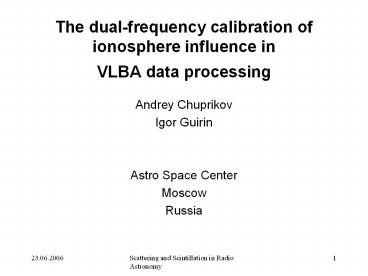The%20dual-frequency%20calibration%20of%20ionosphere%20influence%20in%20VLBA%20data%20processing - PowerPoint PPT Presentation
Title:
The%20dual-frequency%20calibration%20of%20ionosphere%20influence%20in%20VLBA%20data%20processing
Description:
Such delay is 13 times larger at 2.3 GHz due to dispersion ... not a problem because there are calibration tables (TY, GC) in initial FITS-file ... – PowerPoint PPT presentation
Number of Views:34
Avg rating:3.0/5.0
Title: The%20dual-frequency%20calibration%20of%20ionosphere%20influence%20in%20VLBA%20data%20processing
1
The dual-frequency calibration of ionosphere
influence in VLBA data processing
- Andrey Chuprikov
- Igor Guirin
- Astro Space Center
- Moscow
- Russia
2
- The ionized shell around the Earth is caused by
the Sun UV radiation - The electronic column density is peaked at an
height of 350 km above the ground and spreads by
several tens of kilometers around this altitude - The TEC variation has time scale of several hours
and induce a delay of about 1 ns at 8.4 GHz - Such delay is 13 times larger at 2.3 GHz due to
dispersion - Several strategies have been used to calibrate
the ionosphere in VLBI data. One of them is
technique of Dual Frequency Observations
3
- The ionosphere can be calibrated out with
simultaneous observations in two widely separated
frequency bands. Usually, these are - X Band (8.4 GHz)
- S Band (2.3 GHz)
- A linear combination of group delays in these
bands yields straightforwardly the
ionosphere-free delay
4
Description of the experiment
- We present some results of VLBA experiment titled
RDV14. Observations had been carried out on
15/04/1999. FITS-file has been created with VLBA
correlator and then placed into archive - Later, these data have been kindly placed at our
disposal by Dr. L. Petrov (Goddard Space Center)
5
Frequency structure of initial data
- F0 (MHz) DF (MHz) nCh
- IF1 2221.22 8 16
- IF2 2241.22 8 16
- IF3 2331.22 8 16
- IF4 2361.22 8 16
- IF5 8406.22 8 16
- IF6 8476.22 8 16
- IF7 8791.22 8 16
- IF8 8896.22 8 16
6
List of sources observed Source RA
(2000) DEC (2000) Flux Jy S-band X-band
2.3 GHz 8.4 GHz 1 0003-066 000613.892894 -06
2335.33530 1.0 2.2 2 0106013 010838.771074 01
3500.31714 1.7 2.0 3 0119115 012141.595043 11
4950.41313 0.9 1.5 4 0229131 023145.894054 13
2254.71627 1.1 1.0 5 0235164 023838.930108 16
3659.27471 0.9 1.0 6 0336-019 033930.937787 -01
4635.80399 2.0 1.8 7 0528134 053056.416744 13
3155.14955 2.0 2.3 8 0539-057 054138.083384 -0
54149.42839 1.0 1.0 9 0552398 055530.805608 3
94849.16500 3.2 5.4 10 0718792 072611.735177
791131.01624 1.0 1.0 11 0727-115 073019.112472
-114112.60048 2.0 2.3 12 0823033 082550.3383
55 030924.52014 1.2 1.5 13 0851202 085448.874
925 200630.64088 1.4 1.8 14 0923392 092703.01
3916 390220.85195 4.4 11.0 15 0953254 095649.
875361 251516.04977 1.1 1.1 16 0955476 095819
.671648 472507.84250 0.9 1.0 17 1032-199 10350
2.155274 -201134.35975 1.0 1.0 18 1044719 1048
27.619917 714335.93828 1.3 1.0 19 1124-186 112
704.392448 -185717.44166 1.4 2.2 20 1308326 13
1028.663845 322043.78295 1.7 1.8 21 1418546 1
41946.597401 542314.78721 1.0 1.0 22 1606106
160846.203179 102907.77585 1.3 1.1 23 1638398
164029.632771 394646.02854 1.2 1.0 24 173952
2 174036.977850 521143.40750 1.2 1.0 25 1741-0
38 174358.856137 -35004.61668 4.0 4.0 26 1749
096 175132.818573 93900.728510 1.6 3.6 27 1803
784 18045.683918 782804.01851 1.7 1.6 28 1830
285 183250.185631 283335.95530 1.0 1.0 29 190
8-201 191109.652893 -20655.10907 3.2 2.8 30 19
58-179 200057.090448 -174857.67251 0.8 1.3 31
2128-123 213135.261758 -120704.79588 1.5 2.1 3
2 2145067 214805.458679 065738.60422 2.6 7.0
33 2234282 223622.470860 282857.41329 1.0 1.0
7
Data processing
- The main idea was to use a brightest and compact
source titled 0923392 (No. 14) (alternative
titles are J09273902 or - 4C39.25) as a Fringe Finder
- Then, due to phase stability of VLBA equipment,
it is enough to interpolate the GAINs obtained
and to apply them to any other source to
reconstruct the phase of visibility function
8
Data processing
- The a priori amplitude calibration is not a
problem because there are calibration tables
(TY, GC) in initial FITS-file - The trick is to compensate the ionosphere-free
delay before Self-Calibration with multiplication
the Visibility by
9
- Results of data processing
- DA193 (J05553948) without usage of procedure
10
- Results of data processing
- DA193 (J05553948) with usage of procedure
11
- Results of data processing
- 1741-038 (J1743-0350) without usage of procedure
12
- Results of data processing
- 1741-038 (J1743-0350) with usage of procedure
13
References
- Fey, A.F., et al., 1996, ApJSS, 105,
- 299 - 330
- Brisken, W.F., et al., 2000, ApJ, 541,
- 959 - 962
14
- Conclusions
- Our experience demonstrates, that usage of
dual-frequency calibration of VLBA data can
essentially improve the source image even if it
is a strong calibrator - If procedure has not been performed for any data,
the final source image can be shifted from the
phase center, and, additionally, image may have
the false components in this case - The similar results have been published by other
authors (Fey, A.L., 1996), (Brisken, W.F., 2000)
15
The Astro Space Locator Software
- Please, contact with me
- Andrey Chuprikov
- Astro Space Center, Moscow, Russia
- achupr_at_asc.rssi.ru































